Tiny Stations and Communal Tables: Individual Space in Public
We are creatures who like privacy and autonomy. We like to have bounded space when we sit down to do individual work, demonstrating the clear line between what’s mine to use and what’s yours to use. We appreciate not having to fight someone’s elbows or stage our things elaborately to maintain a respectful distance. Successful space planning accounts for this, and carves out spaces that are at least hinting that, while seated at them, you can pretend that you’re alone and not sharing space.
Do we hate sharing space?
Maybe it’s just that the rules are clearer with spaces like the one pictured above. It’s small, yes, and it’s not the most comfortable, but it has everything you need: a place to put your backside down, a flat surface to rest your elbows, computer, or book, power, and, nicely, a view. It’s facing away from other people, from the traffic directly behind you. Once seated, you assume the don’t bother me stance.
This space is in the Library Store Whitechapel (which is, let me underscore once again, amazing). It’s one of many like it, and this was the only one I could find that wasn’t occupied. The rules of this seat are fairly obvious: it’s empty, take it. You don’t need to answer to anyone. Do as you will. I must say, coming from Canada, I was really surprised to see such a tiny space. It really goes to show how lucky we are when it comes to space; the US study space standard seems much bigger to me, but this is what patrons in London are happy to find.
While it seems obvious to anyone that human beings tend to prefer individual spaces to shared ones, I think the story is quite a bit more complicated than that; as a culture, I think we actually love shared space, as long as it’s well-designed and accounts for our needs. How else to explain why some spaces (like libraries) are often packed, but computer labs nearby are empty? If no one’s in them already, no one wants to be in them. at the UTM library, we have students sitting on the floor in the library, together, while computer labs in the building next door sit open and entirely empty. People tend to like to be where other people are, but like to maintain their own sense of space and autonomy while there. That’s the fine line we need to walk when considering spaces for people.
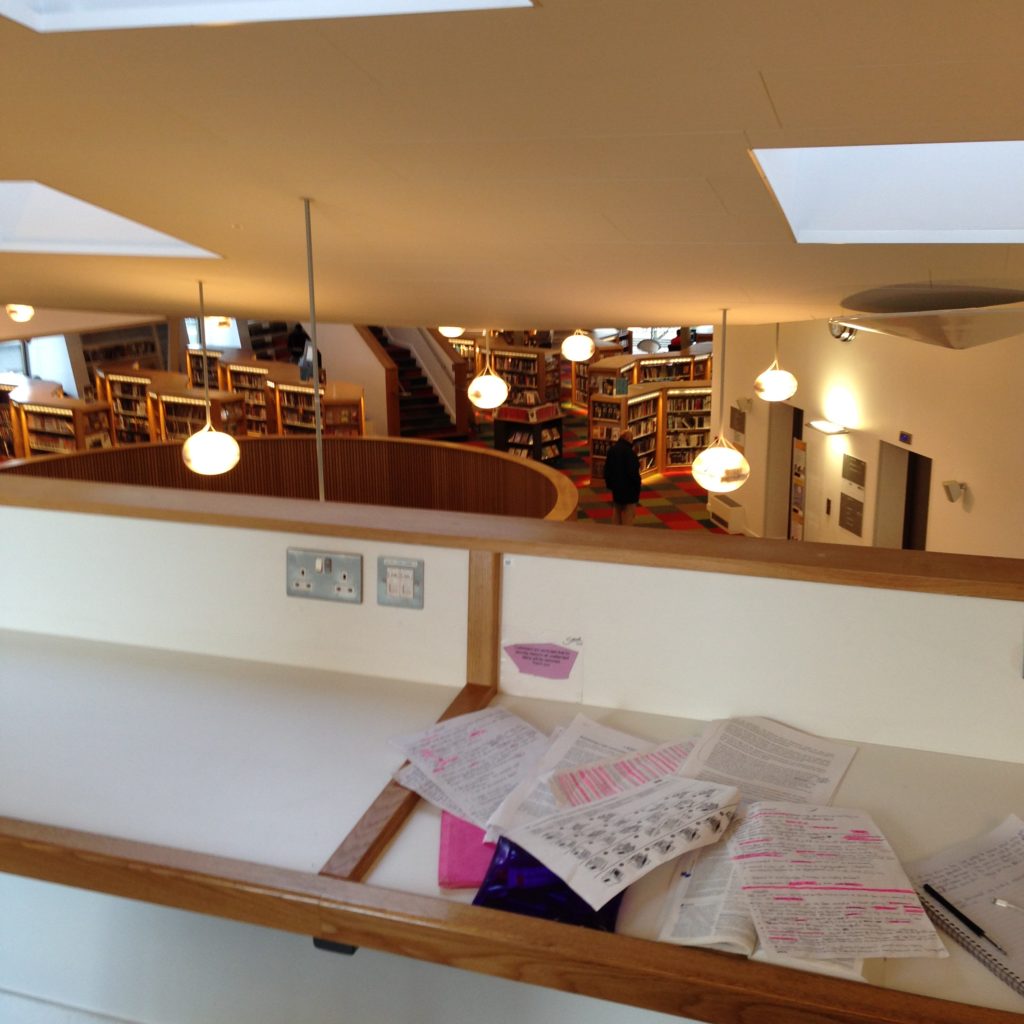
This is a study area in the Canada Water library. There are, I think, some fatal flaws in the design of this library, but you can see all the attempts to make it more user-centered and thoughtful. These study spaces are one of those thoughtful pieces, even though there are some critical problems with it.
The study spaces are simply a long ledge built into the wall along the very top level of the building, looking over the collection. Again, the posture you assume seated at this study area is don’t bother me. You’re facing out, not inward toward your neighbours or toward anyone coming up the stairs. You are looking outward, there is a sort of visa in front of you, and you are winged on each side by spaces doing the same thing. I really like this approach. I think it tells you that it’s a silent study area without you having to articulate it in words.
What’s also interesting about this study space is the absolute lack of barriers between one study area and another. I’m not sure what to think of that, but I could see, walking through this area (it was very hard to find a place to get a shot of it, because it was packed) that everyone respects that tiny strip of wood that marks the line between your space and my space. Barriers would make the space uglier, and I’m not sure whether or not patrons would appreciate them or not. Those might be one of those things we feel like people want, but maybe they don’t. The patrons who use this space will use it for shorter spans of time than, say, a staff member seated at her desk day in and day out. The privacy needs here might be lessened because of that. It might be that all you need is to designate the line so that no one fights for space. As I said, this area was very popular.
It’s fatally flawed, though, because the area below, quite bizarrely, contains the children’s library. So they have children’s programs going on underneath the noses of a bunch of students doing their homework. Not ideal. But I think study areas like this overlooking collection spaces could work really, really well in areas where that collection space is not a noisy location.
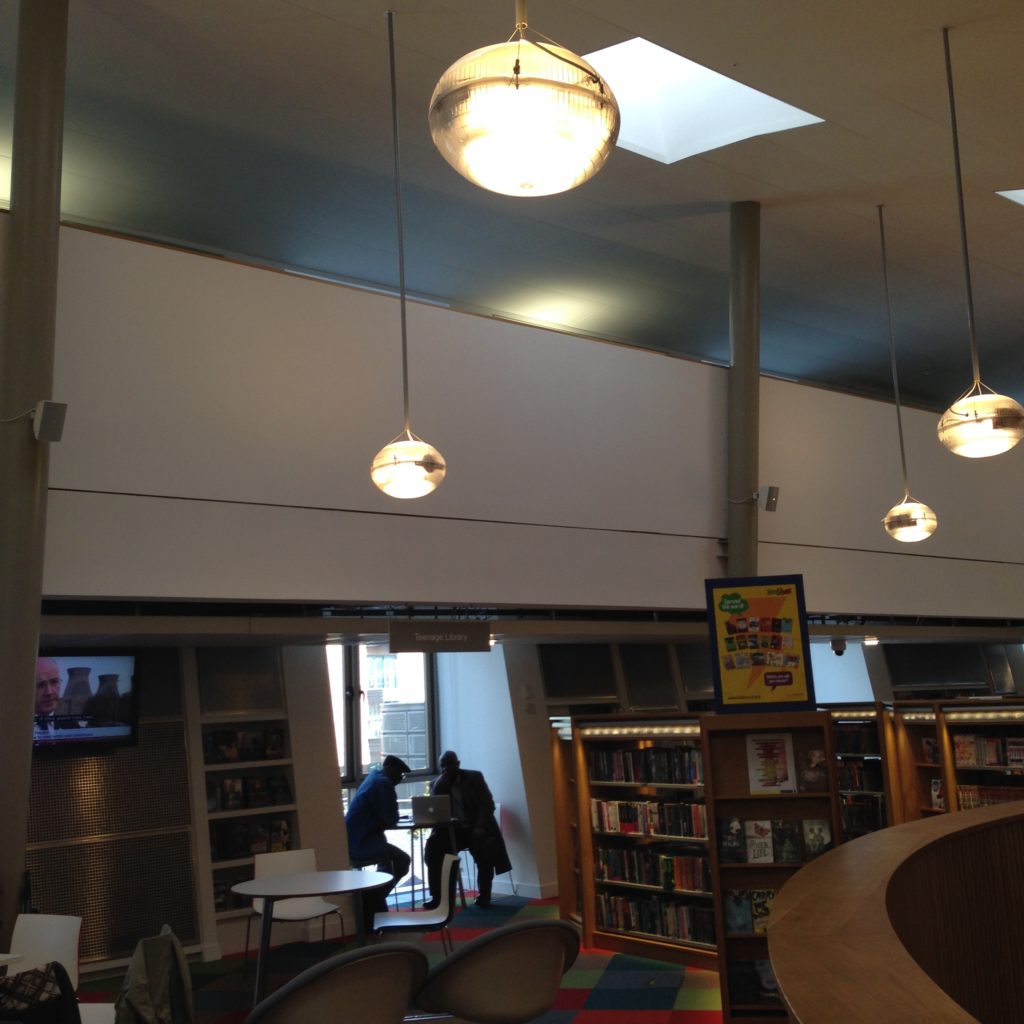
This is a really difficult library to photograph, but as you can see here, the band of wall above hides the study space that ring the whole floor, all facing outward, and there’s low collection and tables below. I suspect if it weren’t for the children’s area, this set up would work well. I love how tucked away they are. It seems like the perfect teen homework zone; it’s a cozy nook at the top of the library, it’s got a view peering down at the rest of the world going about their business, keeping it from being lonely and depressing. There’s power outlets, and at the first floor, at the centre of this library, a full cafe, the smell of which drifts up to the top floor. (That seems like a mistake and possibly a problem with the A/C, but when it’s cookies and coffee, it’s kind of an interesting design choice, really.) Teens and cats; both apparently fans of hidden, high places with a view.
Another, less successful teen study area. I say less successful mostly because I was able to take a photo of it. (I try not to get patrons into photos as much as I can, though I am always taking these pictures with the permission and full awareness of the library staff.) This space is in the new Idea Store Watney Market in Shadwell, which is a short walk from the Whitechapel branch. This branch is nowhere near as busy as the Whitechapel Idea Store, but there were a few teens here when I visited. But they were seated in computer area to the right of this area, which looks down into the beautiful glassed-in stairwell, using individual work spaces as communal ones. This area is lovely, with really nice chairs, but the table is too narrow, the space you can take up too undefined, and you’re face is practically pushing up against nothing but wall. You still get the sense that this is individual space rather than collaborative space, but I’d imagine this is the last space that will get claimed. It’s just too difficult to use. Small can work, but it has to be the right kind of small.
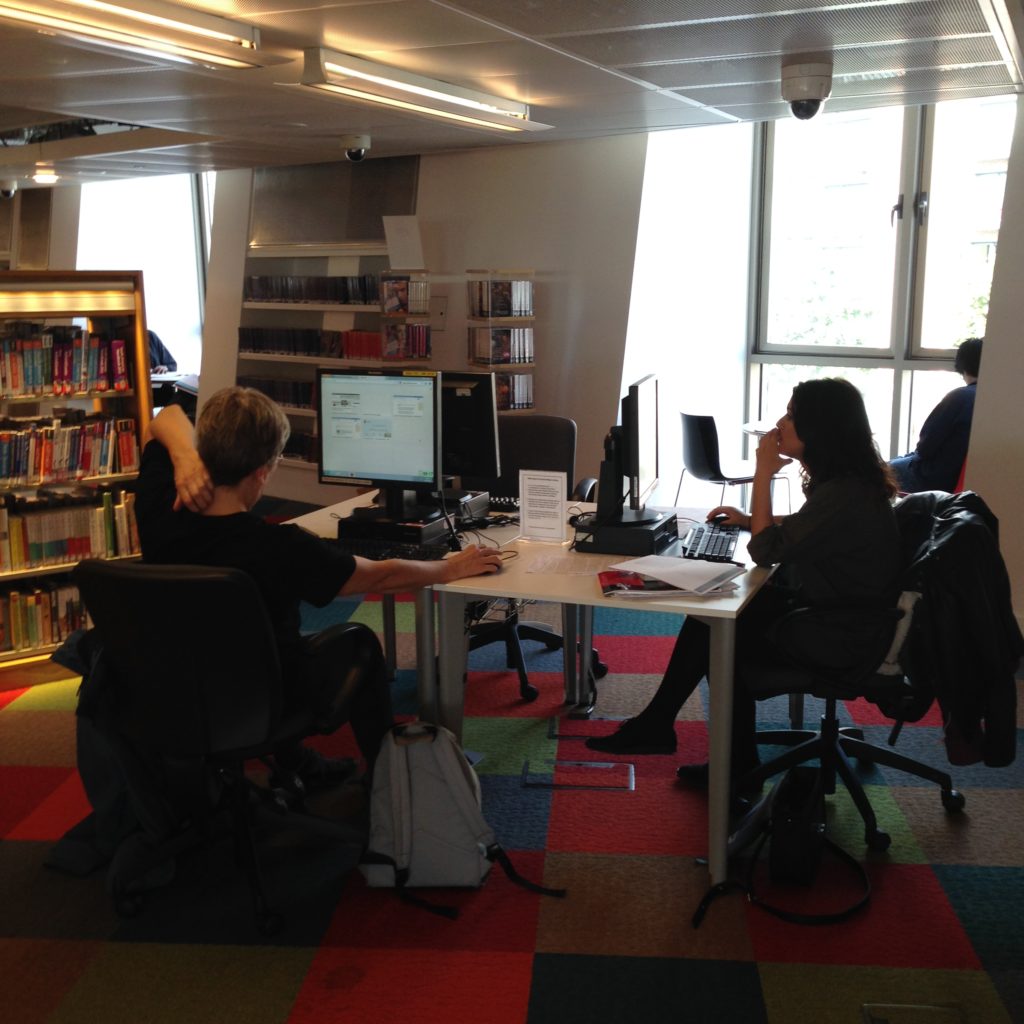
Individual computing, Canada Water library. I’m genuinely conflicted about this. It’s a good use of space, and clearly in use. I like the barrier-free look, but is it comfortable when someone is sitting directly across from you, and you run the constant risk of staring meaningfully into a stranger’s eyes?
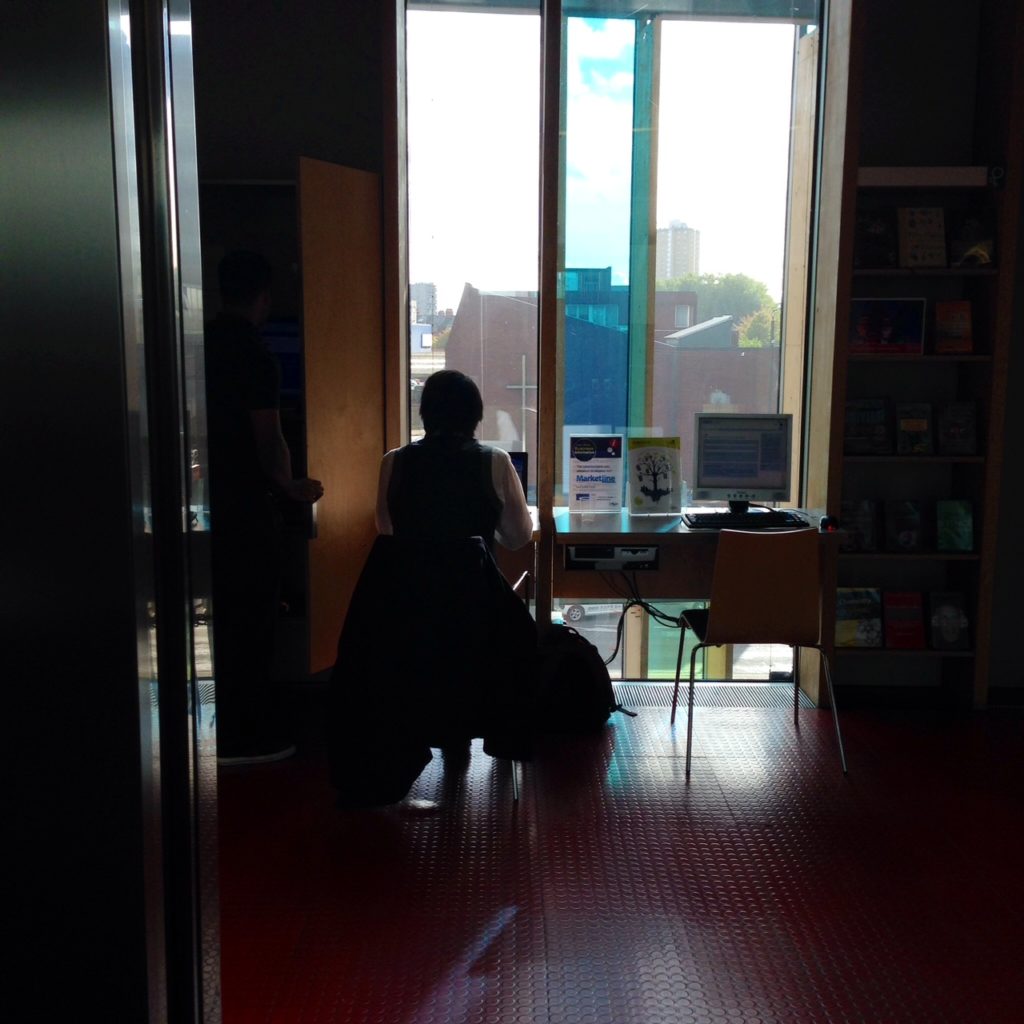
Individual computing, Idea Store Whitechapel. No chance of an accidental staring contest here. Sorry it’s so dark; it was a beautiful, bright day. As you can see, once again, it’s a small space you get to claim, by North American standards. There isn’t a lot of room to spread out. But, thoughtfully, these are spaces for spreading out. These are spaces for sitting in front of a computer, not for laying out an outline or working with books. I appreciate the varied approaches to respecting that difference in that activity. Not all spaces need to conform to all needs. Also, thoughtfully, this is a space that looks outward, underscoring the individual nature of the work they expect will go on here. I’d worry about glare, but to be fair, this isn’t the sunniest country in the world. I say that with affection.
What I remain deeply interested in is the other ways to create individual spaces, the more challenging ways. I genuinely don’t know if this will work, but history says it has worked in the past, and there seems to be a kind of pendulum-swing in attempts to bring it back. The communal table.
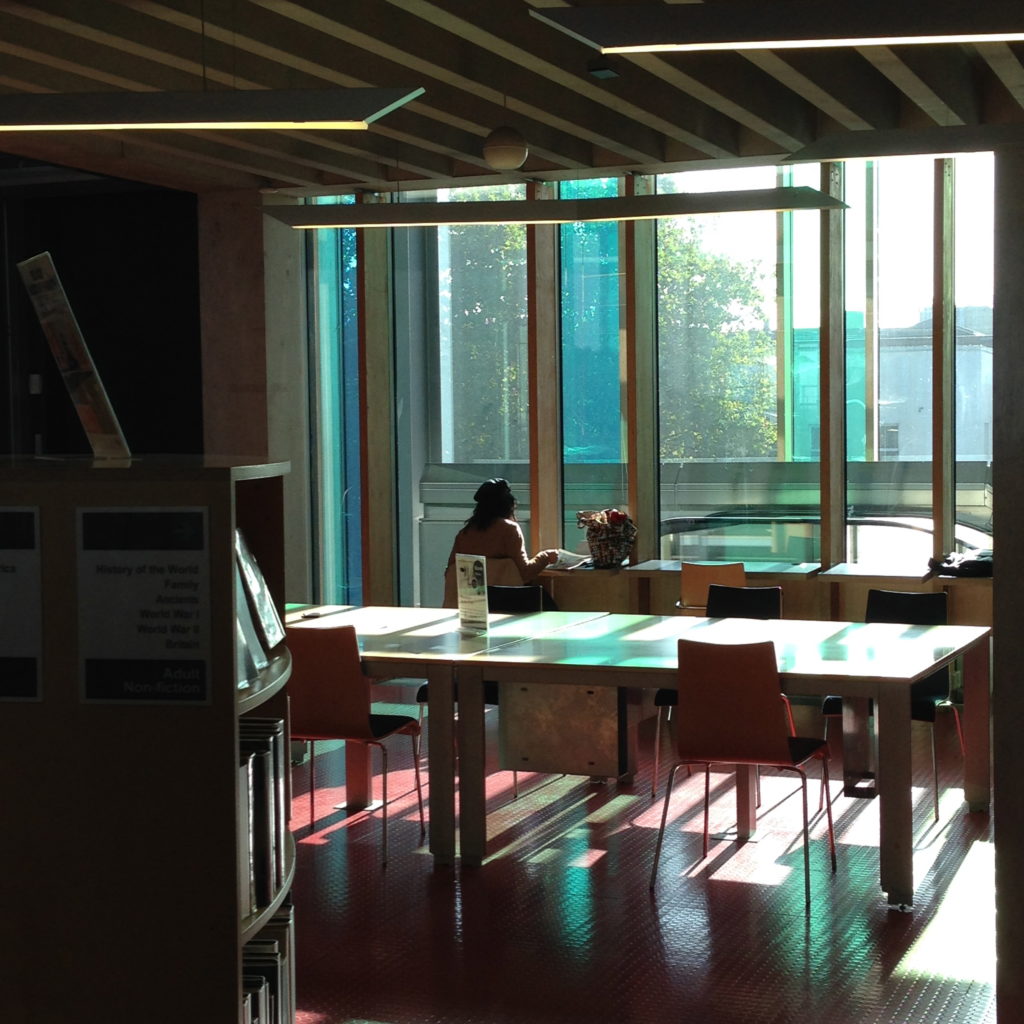
Most shared tables look like this one at the Idea Store Whitechapel. Notice there’s suddenly a lot more room per person; when you’re sitting at a table, you need to designate more room to make people feel more comfortable sitting there on their own doing their own work. This still isn’t a collaborative table; the chairs are too far apart. Notice the only patron in this area chose the narrower table that’s looking out, more easily self-defined.
We used to get a look of mileage out of reading rooms. In my own experience at UTM, reading rooms can quickly turn into cafeterias, shouting, pizzas and all. Is there still a place for these kinds of shared tables?
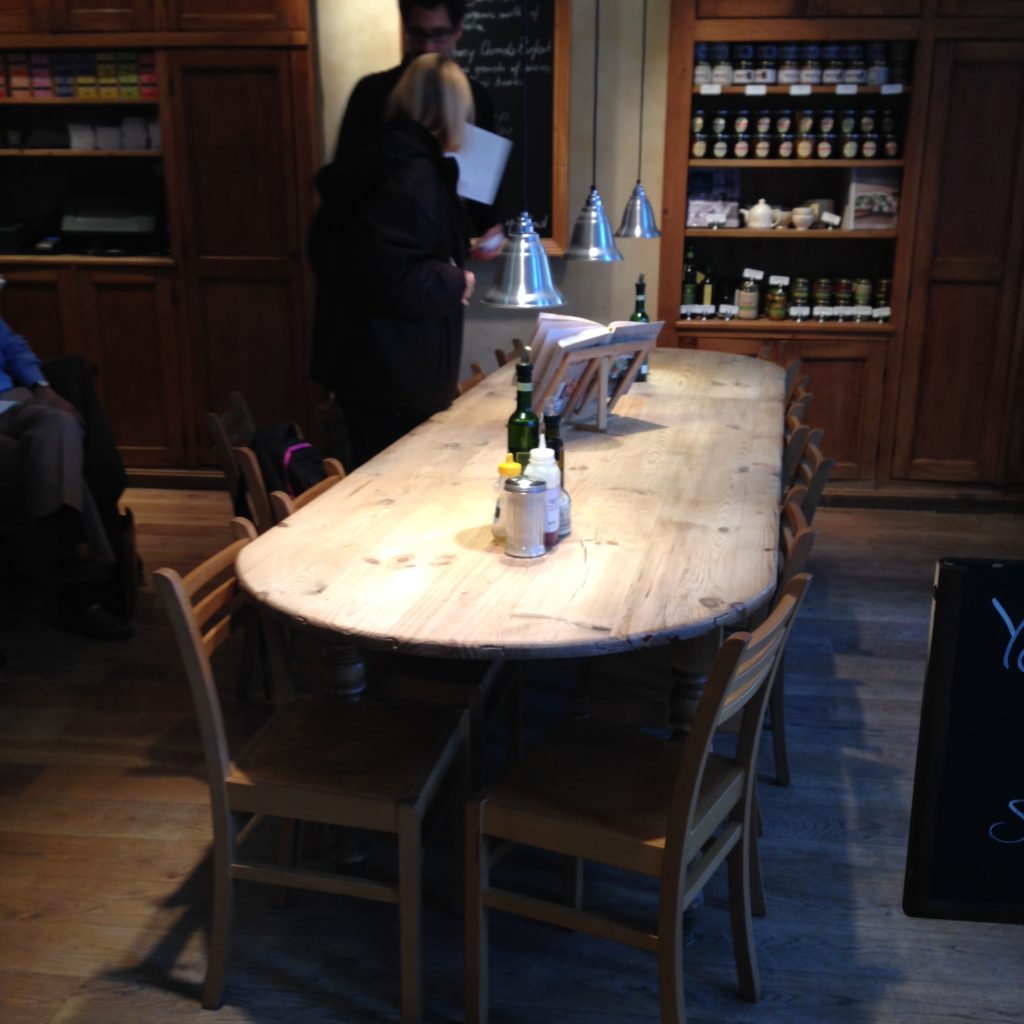
This is an advertised Communal Table in a bakery/café in Hampstead, just down the road from my flat. It’s never for one party, it’s always for individuals or pairs who end up sharing a table like a family. The staff facilitate this by seating you there, which takes away some of the awkwardness. It’s not designed for small groups, though; it’s designed to get strangers to interact with each other, if they’re willing to. Or not; sit and have your coffee, read a book. But you’re part of a greater whole when you sit here with others. You’re part of a community.
Because of the wide variety of activities that take place in a library, libraries need to contain a wide variety of kinds of space. Individual work space that shows in its design that it’s for individuals studying is critical; but keeping it somehow connected with the life of the space going on around it seems key. Large shared space seems to be coming back, perhaps in part because it’s more flexible. These shared tables can work for individual study, or for collaborative groups of all kinds, depending on need. I’m looking forward to seeing more spaces that fit into this spectrum.
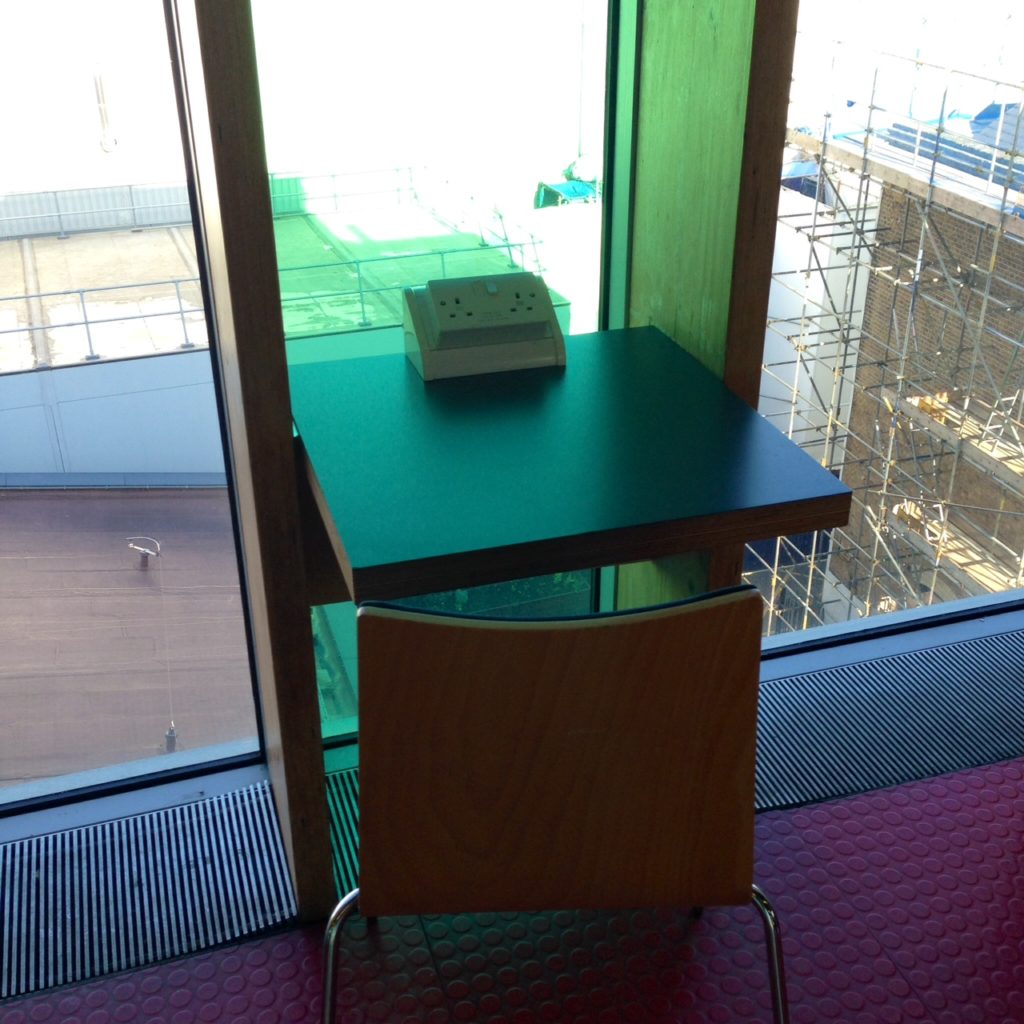
0 thoughts on “Tiny Stations and Communal Tables: Individual Space in Public”
Tiny Stations and Communal Tables. http://t.co/d5BjadIFW6